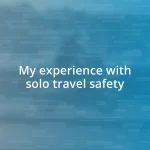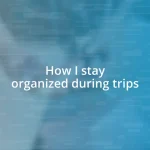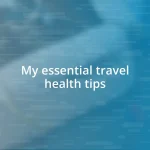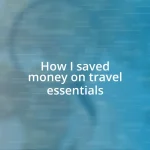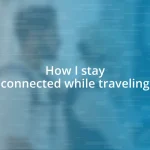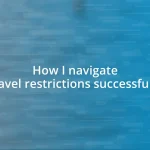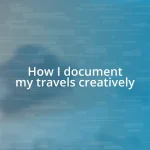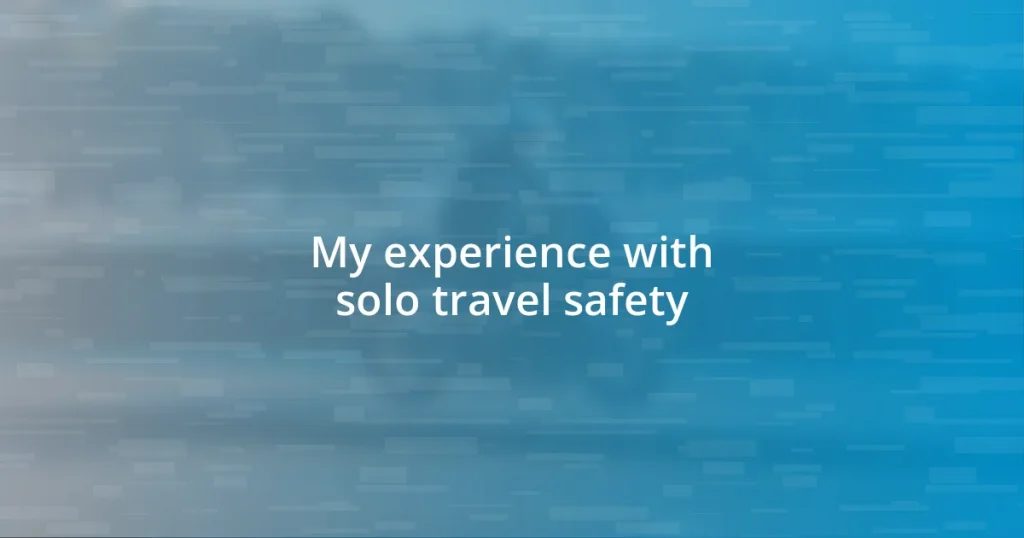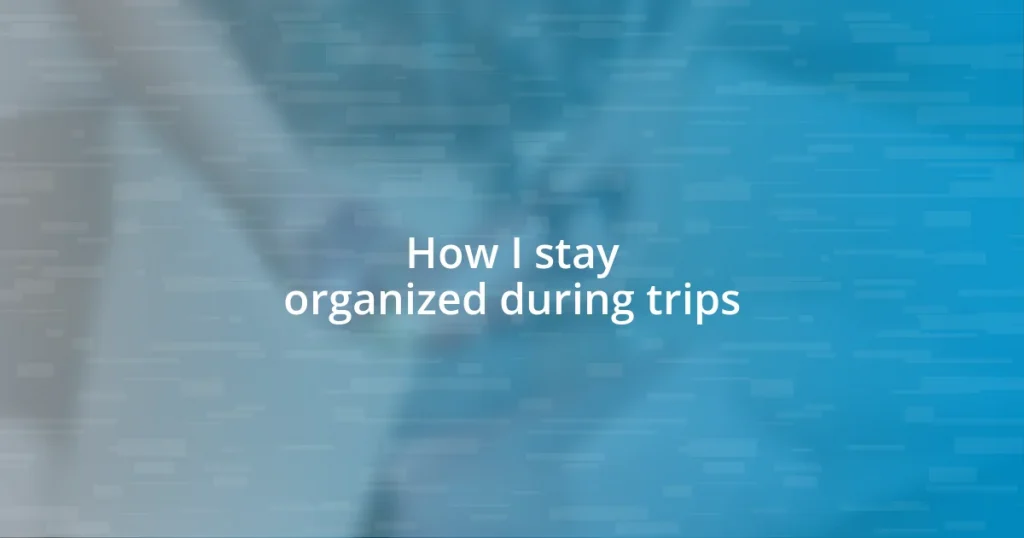Key takeaways:
- Solo travel safety requires a balance of awareness and enjoyment, emphasizing the importance of preparation and understanding local customs.
- Choosing destinations involves researching safety ratings, transportation reliability, and cultural norms to enhance security and comfort.
- Effective emergency management includes having a clear plan, knowing local emergency services, and maintaining a small emergency kit for unexpected situations.
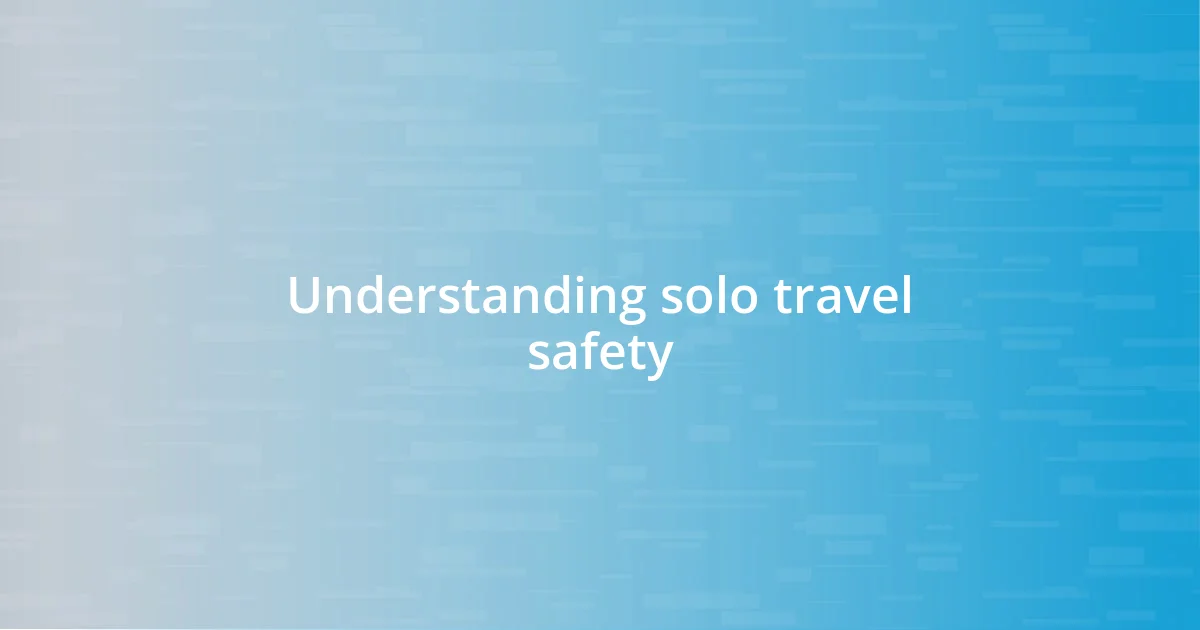
Understanding solo travel safety
When I first embarked on my solo travel journey, the idea of safety felt a bit daunting. I remember standing in a bustling airport, heart racing, wondering if I was truly ready to navigate a foreign land alone. It made me realize that understanding solo travel safety is not just about finding the safest routes; it’s also about building confidence in your instincts and decision-making skills.
There was an incident in a crowded market where I almost lost my wallet because I was too distracted by the vibrant colors and sounds around me. That experience taught me the importance of remaining aware of my surroundings, even when I’m caught up in the excitement of exploration. I find it vital to take necessary precautions, such as utilizing money belts and keeping important belongings secure, yet I also allow myself to enjoy the moment—balancing alertness with the thrill of discovery.
Have you ever felt nervous about traveling alone? I can relate, and it’s completely natural. Preparing for solo travel safety doesn’t mean you have to live in fear; it’s about arming yourself with knowledge and strategies. From researching local customs to understanding emergency contacts, each step contributes to a safer and more enjoyable adventure. It’s reassuring to know that with a little preparation, you can embrace the freedom of solo travel while prioritizing your safety.

Preparing for your solo trip
Preparing for your solo trip involves more than just packing your bags; it’s about strategic planning and mindset. I recall the night before my first solo adventure, I couldn’t sleep because I was going over the itinerary in my head. Each detail—from accommodation addresses to transportation options—was like a little anchor, grounding me and giving me confidence. Knowing I had a plan in place made the idea of exploring alone feel less intimidating.
Another crucial aspect is to stay informed about your destination. I often spend hours researching the neighborhoods I’ll be visiting. I specifically look into traveler reviews and local forums to gather tips about safety and cultural norms. For instance, I discovered that certain areas in my destination were best visited during daylight hours. This proactive approach really paid off when I found myself confidently wandering through a previously planned route, rather than relying solely on chance.
Equipping myself with digital tools has also become a part of my travel routine. I download maps, translation apps, and local emergency contacts before departure. I found that having everything organized on my phone provided peace of mind, especially when my plans shifted unexpectedly. I remember one instance where my train was canceled, and having useful apps at my fingertips helped me quickly find alternate routes and accommodations, making me feel empowered rather than lost in a foreign city.
| Preparation Tips | Personal Experiences |
|---|---|
| Researching neighborhoods | Helped avoid unsafe areas |
| Creating a detailed itinerary | Boosted my confidence |
| Downloading essential apps | Enabled quick decision-making |
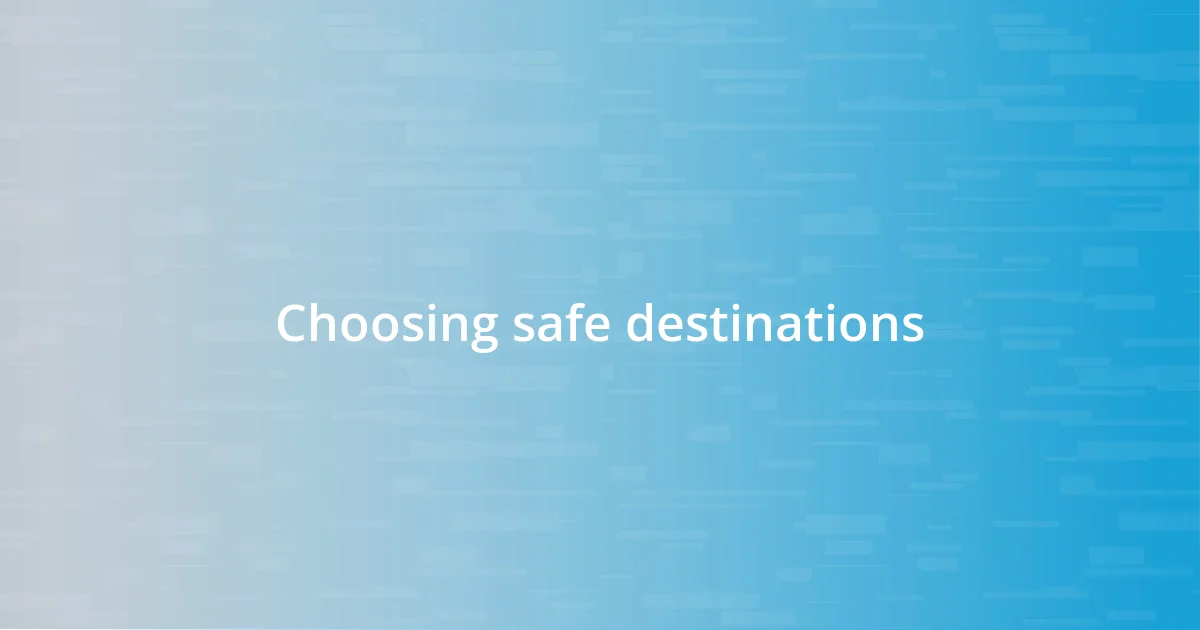
Choosing safe destinations
When it comes to choosing safe destinations, I approach this aspect with a blend of intuition and research. I’ll never forget the time I chose to visit a quaint coastal town that my friend had raved about. I quickly learned that while it looked beautiful, it was notorious for petty thefts. That experience underscored the importance of not just falling for picturesque photos but digging deeper into safety statistics and traveler insights.
Here are some key factors I consider when selecting a destination:
- Local Safety Ratings: Look for destinations rated favorably in terms of general safety and crime rates.
- Transportation Safety: Investigate the reliability and safety of local transportation options—public transport can sometimes be more risky than expected.
- Travel Advisory Services: I refer to government travel advisories for up-to-date information on potential risks.
- Cultural Understanding: It’s crucial to understand cultural norms and customs that might impact your experience. I remember learning about dress codes in certain countries and how that significantly enhanced my safety and comfort.
By taking these steps, you’re setting yourself up for a more enjoyable adventure while keeping safety at the forefront.
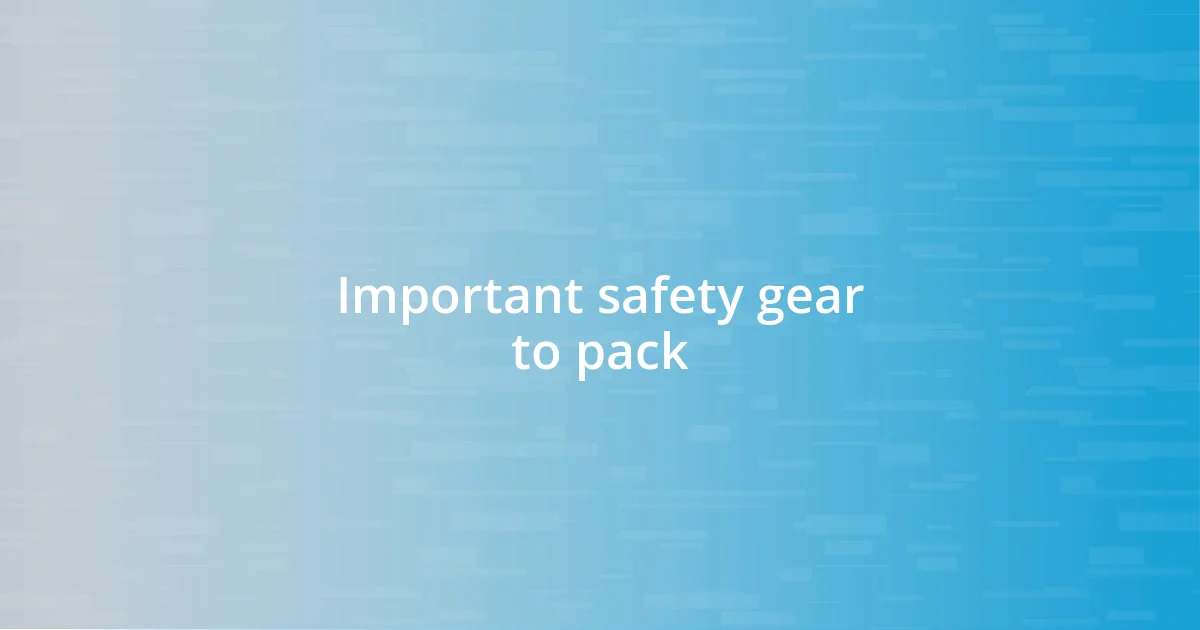
Important safety gear to pack
Packing the right safety gear can significantly enhance your peace of mind while traveling solo. One essential item I never leave without is a personal safety alarm. I remember feeling a rush of confidence the first time I attached it to my bag. Just knowing that I could create a loud noise if I ever felt threatened made a world of difference. It’s a small yet powerful tool that can deter unwanted attention and alert others if you’re in need of help.
Another item that stands out in my packing list is a travel first-aid kit. The first time I ventured into a remote area, I underestimated how comforting it was to have band-aids, antiseptic wipes, and pain relievers right at my fingertips. There was a moment when I accidentally scraped my knee while hiking, and having my kit made all the difference. It’s not just about treating injuries; it’s about the reassurance that I can manage small mishaps independently while on the road.
I also swear by carrying a multi-tool. This nifty gadget has saved me on several occasions, from opening bottles to making minor repairs when things didn’t go as planned. It’s hard to describe the relief that washes over you when you realize you have a solution right in your pocket. Have you ever been in a situation where you just wished you had one small tool? That’s what makes a multi-tool an invaluable addition to your travel gear.
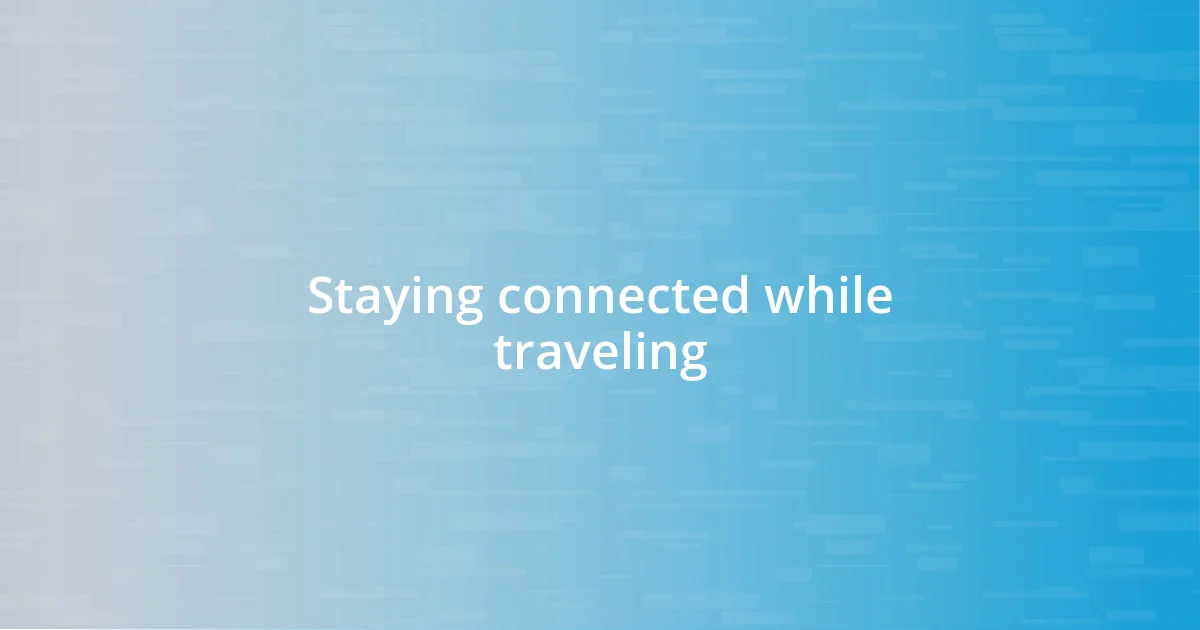
Staying connected while traveling
Staying connected while traveling is crucial, especially when you’re exploring unfamiliar places. I always make it a priority to have a reliable mobile device with me. During one trip, I remember being on a secluded beach, and I faced a technology mishap when my phone died unexpectedly. In that moment, I felt vulnerable and anxious. But since I had also downloaded offline maps and essential info beforehand, I was able to navigate back safely without internet access. That taught me the importance of preparation in maintaining connectivity.
Another effective strategy I’ve found is to use local SIM cards. On one occasion, I was traveling in Europe and decided to pick up a local SIM when I landed. Not only did it save me on roaming charges, but it also allowed me to easily communicate with locals and plan my day. The sense of freedom I felt, knowing I could contact my accommodations, locate nearby attractions, or even send updates to family was incredibly empowering. Have you ever felt the relief of knowing help isn’t just a phone call away?
Lastly, I can’t emphasize enough the value of social media and messaging apps for staying connected with friends and family while abroad. I recall a time when I found myself in a bustling city square, and I immediately shared my location and plans with a close friend through a group chat. That small act made me feel reassured, knowing someone back home was in the loop. It’s amazing how technology allows us to keep our loved ones close, even when thousands of miles apart. What would we do without these connections?
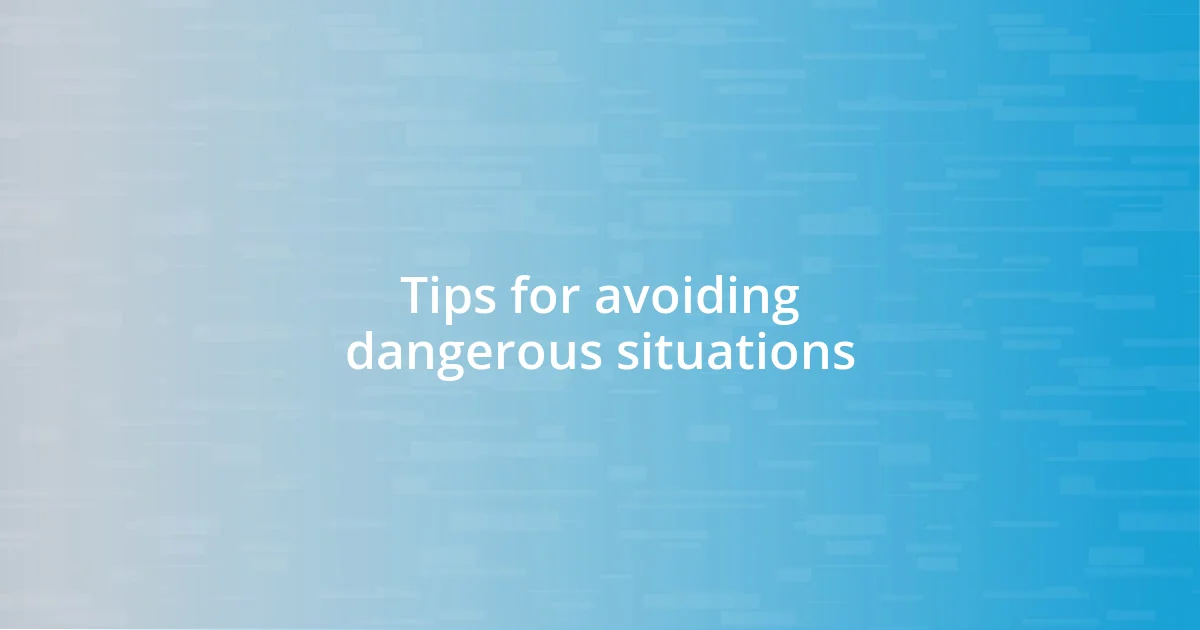
Tips for avoiding dangerous situations
When it comes to avoiding dangerous situations, I’ve learned that being aware of your surroundings is crucial. One evening in a new city, I found myself engrossed in my phone while walking. Suddenly, I realized I had wandered into a less populated area just as dusk was falling. That moment of distraction shook me and served as a reminder that it’s essential to stay alert – not just for your safety but to truly experience your surroundings. Have you ever felt that unsettling rush of panic when you realize you’ve lost focus?
A great tip is to trust your instincts. There was a time when I was approached by someone who seemed friendly but gave off an unsettling vibe. I could hear that inner voice telling me to keep my distance, and thankfully, I did. It turned out my gut feeling was right. This experience taught me to prioritize my intuition; sometimes what feels right or wrong might just be the key to staying safe. What does your gut tell you when you’re uncertain?
I also advocate for blending in with the locals. During a trip to a vibrant market, I dressed in simple attire rather than my typical tourist wear. Blending in not only made me feel less conspicuous but allowed me to engage more naturally with the locals. This experience opened doors for me to hear their stories and gain invaluable tips on safe areas. It’s interesting how adjusting your appearance can change the way people perceive you. Have you ever tried something similar?
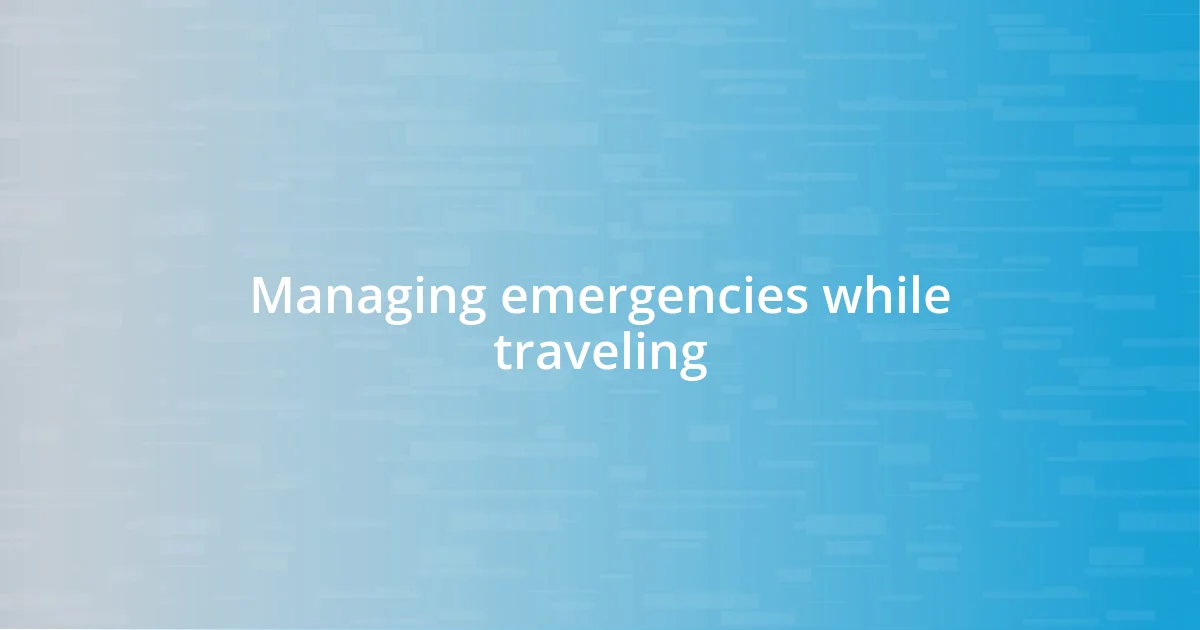
Managing emergencies while traveling
When it comes to managing emergencies while traveling, having a plan in place can make all the difference. I remember once getting caught in a sudden downpour in Southeast Asia, which led to a surprising flash flood that trapped a few of us at a local café. Instead of panicking, I recalled my emergency contact list, which included local friends and the nearest embassy. That prepared me with more options than I initially thought, ensuring I didn’t feel completely stranded. How reassuring is it to know you have a backup plan when things go awry?
One essential tip I picked up is to always have a small emergency kit with you. On one trip, I found myself with an unexpected blister after a long day of hiking. Thankfully, I had some band-aids and pain relievers handy, allowing me to address the issue quickly instead of letting it ruin my adventure. This experience really reinforced the value of being proactive. Have you ever encountered a small mishap turned major problem simply because you weren’t prepared?
Lastly, learning how to navigate local emergency services is crucial. During my travels in South America, I took the time to familiarize myself with the local emergency number and nearby hospitals. One evening, I witnessed a minor accident and was able to act quickly by calling for help, which made me feel empowered. That moment highlighted how important it is to know who to turn to in a crisis. Wouldn’t you agree that being informed can literally change the outcome of an emergency situation?


